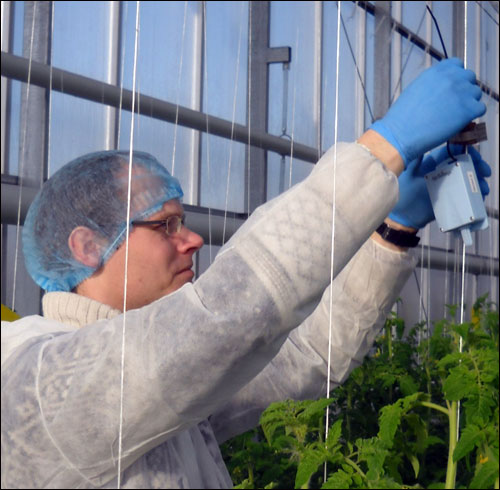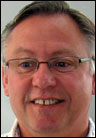German and Dutch greenhouses have become the proving ground for a new wireless tracking solution being tested by researchers at the Wageningen University & Research Center (WUR). The system, now commercially available, is designed to manage the climate throughout the facility where plants are grown.
Managing the climate within large commercial greenhouses can determine whether plants are productive or healthy, says Jos Balendonck, a researcher at theWageningen UR Greenhouse Horticulture research institute. The major driver at Dutch greenhouses management, he explains, is to minimize energy input while preventing crop disease due to high humidity and local leaf wetness. Most commercial greenhouses have some kind of sensor to measure conditions inside the building throughout the day.

Traditionally, Balendonck says, greenhouses employ wired temperature and humidity sensors that detect conditions within their vicinity and transmit that information to back-end software used to monitor greenhouses remotely. One problem with wired solutions, however, is that they can be expensive to buy and install. Therefore, few are typically used. But companies that grow large quantities of vegetables, fruits or ornamental plants within vast greenhouses, he says, can benefit from a more extensive view into the conditions that all of the plants experience—not just those closest to a wired sensor. If the entire climate throughout the building is not being measured, owners tend to overcompensate by controlling the environment in order to ensure that no area within the greenhouse falls outside of acceptable perimeters, without the owner actually knowing whether or not its efforts are successful.
WUR is dedicated to developing innovations for the horticultural industry, to improve product safety and increase productivity. The research institute has developed low-energy watering methods, dry-air distribution systems and light-emitting diodes (LEDs) to cultivate tomatoes. Over the years, WUR has worked with a Dutch firm known as Wireless Value on projects funded by the Dutch Horticultural Product Board. These projects, called Smart Dust 1, 2 and 3, were tasked with developing systems to improve greenhouse health.
For its latest greenhouse-monitoring project, focused on monitoring ambient temperatures and humidity, the WUR research team knew that Wireless Value had already developed a suitable RFID-based sensor system known as WiSensys, for monitoring buildings, and that the company was interested in exploring how the sensors could be utilized for agricultural applications. “We found out that the equipment did a good job,” Balendonck says, “but needed to be adapted for the horticultural market.”
The WiSensys system consists of wireless temperature and humidity RFID sensor tags, as well as repeaters and a base station with a GPRS modem. During the winter season of 2008 to 2009, Wageningen UR’s researchers first tested Wireless Value’s battery-powered 869 MHz RFID sensor tags around its greenhouses in a series of six trials, each for two five-day periods, to learn what kind of information could be captured and how important that data would be. One hundred sensor tags were placed in a grid throughout the greenhouse, clamped onto wires used to support the plants as they grew. Each tag’s built-in temperature and humidity sensors took measurements, and the tags transmitted the data to a repeater that forwarded that information to a base station. The base station employed Novatel Wireless Technologies GPRS technology connected to a PC running SOWNet Technologies‘ software to manage RFID data. Studies found that the temperature and humidity varied widely from one part of a greenhouse to another, Balendonck reports. Some areas were warmer, partly due to the angle of the sunlight, while others were cooler, or more or less humid.
For the next phase in creating a wireless sensor system, Wageningen UR researchers have been testing the technology at several additional locations, including a grower of tomatoes in the Netherlands, as well as a WUR research greenhouse in Germany, with 15 to 20 sensors per hectare. As a result, the company has improved the software so that it now can receive the sensor data and forward it to a user’s climate-control software, thereby enabling the temperature or humidity controls to automatically adjust their settings according to sensor readings.
“The University in Wageningen was, in 2008 and 2009, one of the first customers of this platform for their Smart Dust research work,” says Jouke Miedema, Wireless Value’s CEO. “We received a lot of input from this work, leading to substantial improvements on the platform.”
In response, Wireless Value developed a product called AgriSensys, specifically for the horticultural market. “It is a plug-and-play system,” Miedema explains. “The grower only has to place the sensors in the greenhouse, connect the base station and log in on the hosting site.”
The solution, now being sold by Wireless Value (either directly or through resellers) to farmers throughout Europe, includes the tags, repeaters and base station, as well as SOWNet Technologies’ software for linking sensor data to a user’s climate-control software. The cost varies according to a particular deployment’s size.
Climeco, a Dutch advisory company that helps farmers set up new greenhouses, has begun utilizing the system to view temperature and humidity measurements throughout a newly built greenhouse, in order to then advise the greenhouse owners regarding any conditions they may need to address. The system is then removed and used elsewhere.
“I want to prove that farmers can save energy and reduce their safety margin” with the solution, Balendonck says, by knowing that plants are not being exposed to unfavorable conditions.


